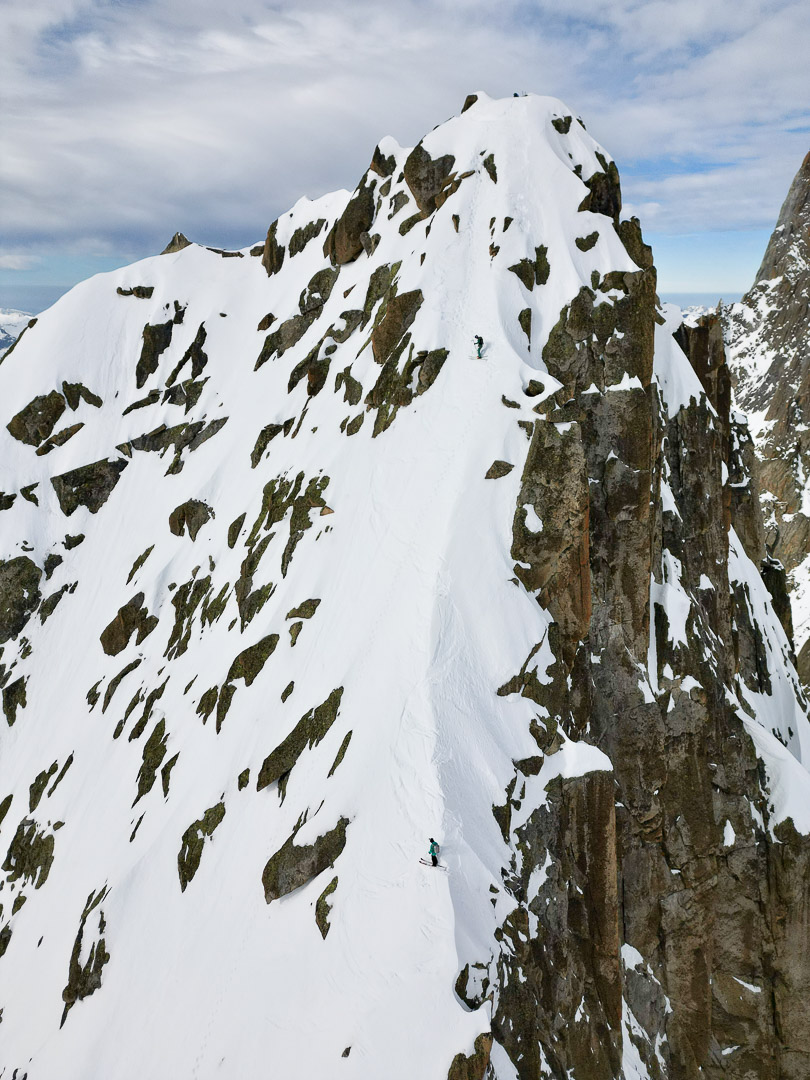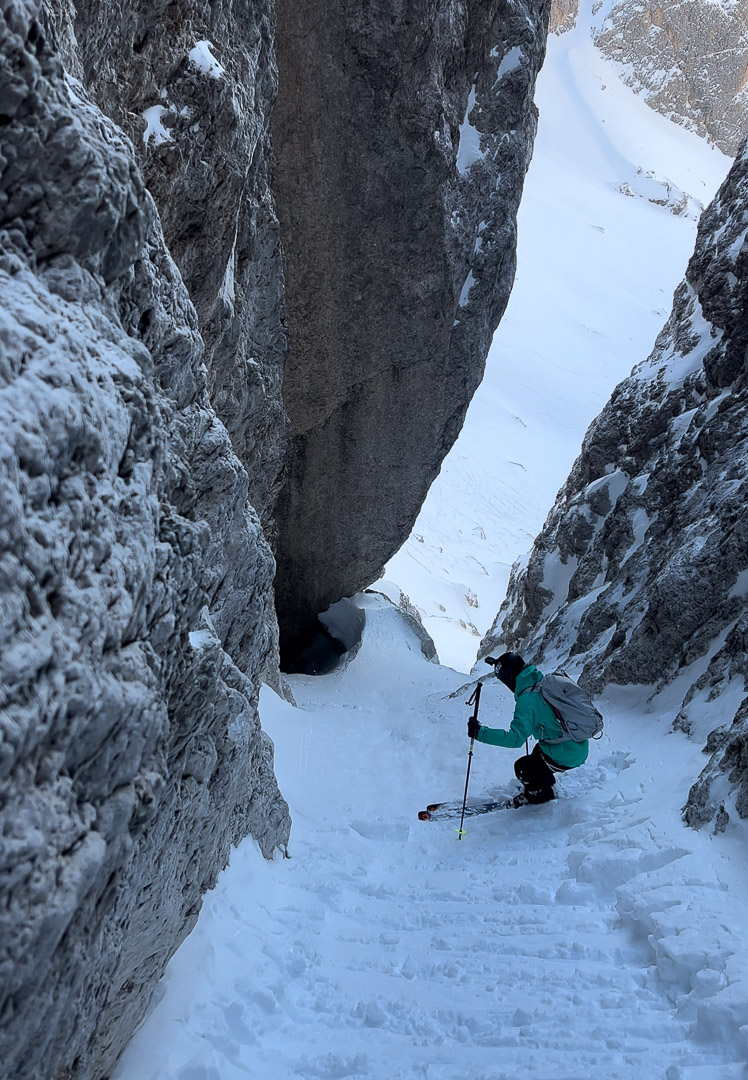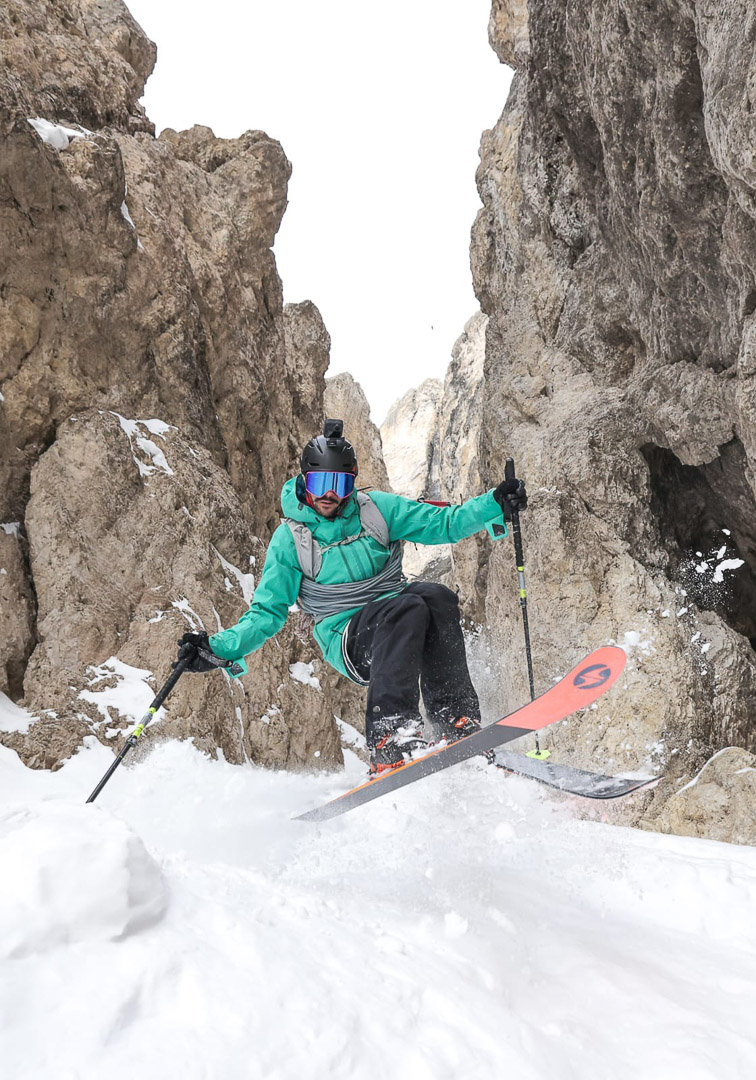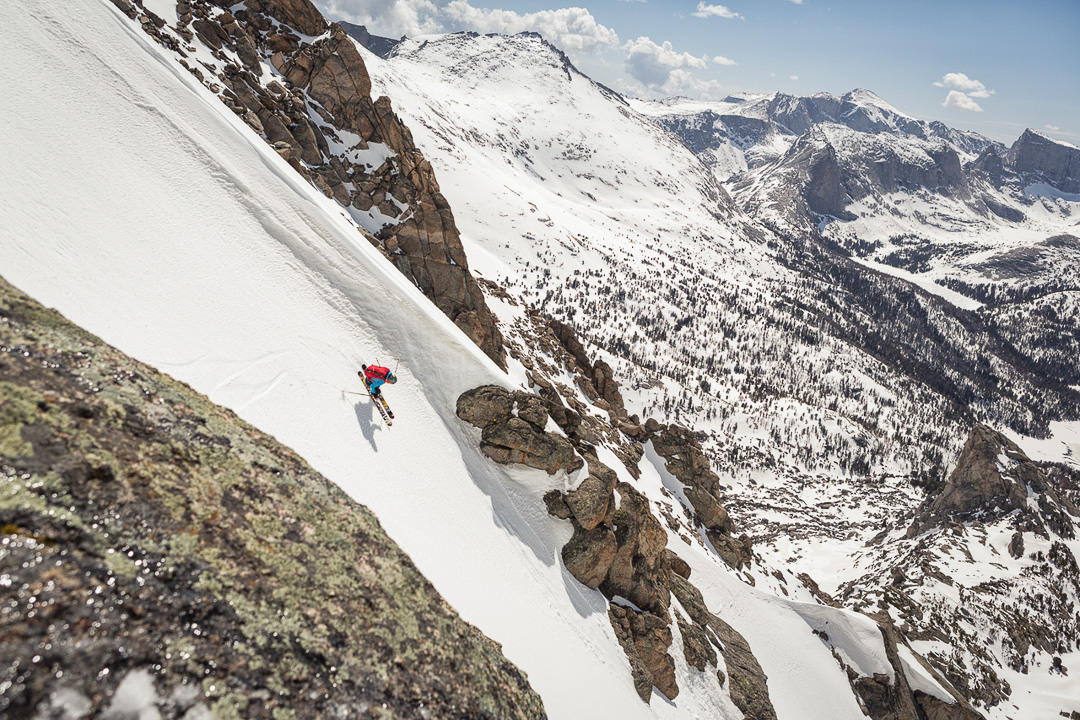Kim Havell and Aurel Lardy are two skiers at home in the steeps. We checked in to learn a bit about their ski choices for steep skiing.
Some of us are experimenters, forging ahead, making mistakes, finding what works, and settling into a groove. Tinkering. On the other end of the spectrum are those taking a more conservative path regarding gear choice; we take cues from others and try not to repeat pitfalls.
Examining what elite skiers use in specific conditions and terrain shows how some choose planks and what attributes we look for. It may seem early, tipping past mid-February, but spring conditions will be upon us soon enough. This swap to a freeze-thaw cycle means objective skiing will be in play. Schedules adjust, ski crampons are unearthed, and we scamper out the door, ascending firm snow and chasing corn. In this episode of Objective Skiing 101, we’re interested in knowing what boards two skiers choose for steeper, more committing terrain when conditions line up. We get answers from Aurel Lardy and Kim Havell, two skiers inhabiting different cultures, snowpacks, and ranges.
Lardy, raised in Chamonix, comes from an alpine racing background and, of late, has been applying his steep skiing craft in the Alps t0 good effect and in Patagonia. (You can chase his skiing down @aurel_lardy)

Kim Havell resides in the Tetons. She is the first woman to ski the Grand Teton’s Otter Body and ski guide the mountain. (She can be found @kimhavell.)
At 27, Lardy comes to the scene weaned on an industry already entrenched in the ethos that a wider (and shorter) is better ethos. For her part, Havell experienced the boom of wider skis that we, maybe, take for granted now. But, still, parsing out the evolution of ski design in a piece of just over 1200 words and simply focusing on width underfoot or in the shovel misses the point. There’s a whole design package clamped to your ski boot, that includes sidecut, camber, rocker, core material, etc. The trend is to have more edge contact in the steeps, which usually translates to less tip rocker, straighter tails, and a stiffer flex profile.
There is no carbon dating here, but there was a time when steeps were sent on 200cm+ skis, and “toothpick” might be what you stuck an olive with and how you described the mm underfoot. The word is that Bill Briggs made the first ski descent of the Grand Teton on a pair of 210cm K2 Elites. Sylvain Saudan, a steep skiing legend in the Alps, began skiing very exposed and very steep lines in leather boots and wooden skis.
Hit the time machine, blast to the future, which is now, and Vivian Bruchez hits the firm spring steeps on an 88mm underfoot 170cm long Dynastar plank. And according to our Gear Editor, he brought 156cm planks on an attempt to climb/ski Dhaulagiri.
Not that it wasn’t a good time to be a skier 50 or more years ago, but we have so many boots, bindings, and skis on offer that it’s hard not to think of the “now” as the golden age for finding what works for you. That said, let’s embrace Adam Fabrikant’s notion of the Golden Age—it’s whatever age you find yourself in. With that mindset, which is a growth mindset, it keeps the door open for the dreamers, the gear designers and tinkerers, and the early adopters among us.
Lardy’s responses have been translated from French and have been lightly edited. Also, for transparency, Lardy’s current ski sponsor is Blizzard. Havell is a longtime Salomon athlete.

THR: How have the skis you choose for objective skiing (meaning the steeps) evolved? Consider length, stiffness, and other attributes like camber, rocker, and overall weight.
Aurel Lardy: I originally come from alpine skiing, I have always been used to skiing with very long and very stiff skis. My technique, like my equipment, had to be adapted to my practice of steep slope skiing. During freeride outings or on steep slopes on large faces I favor long, rather rigid skis with a slight rocker. In addition, I attach a lot of importance to a ski with a large turning radius and a titanium plate.
For my “extreme” steep skiing in narrow, highly technical terrain, I’ve learned to use shorter, lighter skis with a +1 binding mount for better centering. I mainly use the Blizzard ZeroG 105 in 172 cm (I’m 1 m 77 cm tall).
THR: If you expect firm conditions, what objective ski are you choosing?
Aurel Lardy: For difficult conditions, I use the Blizzard Rustler 10. A powerful “giant” ski. In size 180 cm, a relatively straight construction with a titanal plate. Or if I’m touring or going far afield, I’m more likely to use my ZeroG 105. Short, straight and stiff. Efficient when they’re on an angle, even on very hard snow. On my last two expeditions to Denali and El Chalten in Patagonia, I opted for the lightness and versatility of the Zero G 105. Skiing down the Sultana ridge to Mt Foraker in Alaska and skiing down the Whillans Cochrane ramp to the Poincenot needle, for example.

THR: What ski are you choosing if you expect variable conditions for the steep objective?
Aurel Lardy: For changing snow conditions, any ski is complicated to drive. That’s why I prefer a light, easy-to-drive ski like the Zero G 105. A small ski allows you to pivot without too much effort and more quickly than a heavier and/or overly muscular ski. I’ve just come back from the Italian Dolomites, where the wind and heat worked the snow a lot. We skied the mythical “Vallancent” couloir at Le Cristal, and the very low snow cover, wind and heat in the Alps made for a very serious descent. My tools for this were once again the ZeroG 105s.
THR: If you are going on an extended ski expedition involving steep skiing, what skis might you bring along?
Aurel Lardy: On a long expedition, I’m bound to use a ski that’s light and versatile. On our expedition across Denali National Park, we covered over 500km on skis and kayak. The mountains and snow conditions were harsh and changeable. I opted for a touring ski with a 100mm width in a 172 cm length.
THR: If you were designing a ski for steep spring objectives, what would you look for if it doesn’t already exist?
Aurel Lardy: The perfect steep ski already exists, thanks to its rigidity, its (long) curve radius and a Titanal plate under the feet for efficient pivoting without too much effort and strength in the driving phase on all types of snow, even the firmest snow.

Havell was sent the same prompts. Her response is below.
Havell
Since I started steep skiing in the late 90s there has been extraordinary change. The biggest being weight. Then the options came along like a rockered tip and an early rise tail or an early rise tip and tail. I’m not so old that we didn’t have camber.
If I am anticipating firm conditions, I am actually generally on the same ski. The overall ski performance these days is so exceptional that my 106 underfoot can handle expected or unexpected firm conditions. So for the present day I think it comes down to both the tune and the overall shape/sidecut and tip / tail of your backcountry ski. If I was headed out to ski a couloir in the Central High Atlas of Morocco or the French Direct route on Huayna Potosi Bolivia or the Landry Line on Pyramid Peak in the Maroon Bells or the Otterbody of the Grand Teton on a light powder day or on a firm day, I’d be on the same ski. Also, sometimes the line itself is firm but the entirety of the route is not, then it is nice to have a ski that feels solid in variable conditions overall. When we skied the Otterbody, conditions started out bullet-proof up high. We skied down half way on the East face and waited. Then the rest of the route went from corn to deep corn. My ski handled it all well. I have always been on a 104-106 underfoot — this feels solid to me and I can confidently get an edge in, but then adjust to varying conditions. On trips to Greenland, Norway, Antarctica and Iceland, we skied deep powder in couloirs and then went into firm spring conditions that evolved into corn on other aspects closer to the water. My early rise tip and tail managed it all for me. When I skied some of the high peaks in the Himalaya and Karakoram, I always had a relatively “heavier” ski but that gave me higher ski performance and it felt stable when we skied big loads down from high camps.
I am an approx. 20 yr. Salomon athlete so I have been through the evolution of Salomon products. I had to wait a long time to get a lightweight high performance touring ski—that ski for me now is the Salomon ECHO. But, I have loved the Czar, the Shogun/Geisha, QST and more.
I do think some of the skis now have all the components to glide through the change of season and conditions. One addition that I would make is not my own but from my friend Andreas Fransson— he always emphasized the importance of an internal metal plate in wood core skis for drilling in bindings as the bindings can pull out more easily in wood, especially in spring conditions. However, the metal plate can change the absorption of the ski underfoot. I think early rise tip/tail or early rise tip/flat tail is ideal for spring. Too much rocker up front can flop around too much on hard pack (but can be nice in slush).
When you meet the best skiers out there they often say they can ski any ski. Wendy Fisher comes to mind amongst others. So, there is also that age-old adage that the ski does not the skier maketh. But, the ski can make it so much more fun. Bottomline: to ski the steeps you need to be a very strong skier and then match your style to the ski that provides the most enjoyable and the safest experience for your type of turn / flow.
The overall shape of the ski matters in terms of the sidecut. There are skis that some have liked that I could barely turn safely because the sidecut dictated the turn radius and that was uncomfortable. I think this characteristic is highly personal as mentioned in the last paragraph. Though, there are skis that everyone likes and everyone can ski and perhaps this is the universal equation for which companies search.





Leave a Reply
You must be logged in to post a comment.